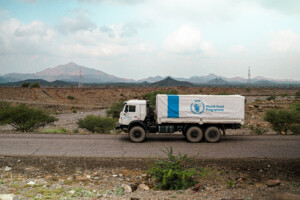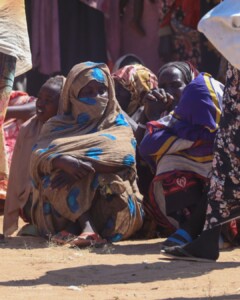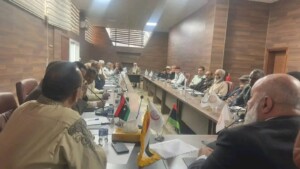Scale-up of cholera response in Sudan’s capital
Sudan’s federal Ministry of Health and the World Health Organisation (WHO) are working with partners and at-risk communities to scale up surveillance of cholera in Khartoum. On November 7, the final phase of the five-year yellow fever vaccination campaign was launched. The campaign will target more than 30 million people across Sudan. According to the Sudan Metrological Authority, rainfall in the country has been persistently above average throughout most of the 2019 season.

Sudan’s federal Ministry of Health and the World Health Organisation (WHO) are working with partners and at-risk communities to scale up surveillance of cholera in Khartoum. On November 7, the final phase of the five-year yellow fever vaccination campaign targeting more than 30 million people across Sudan was launched. According to the Sudan Metrological Authority, rainfall in the country has been persistently above average throughout most of the 2019 season.
The Sudan Humanitarian Fund has disbursed about $3 million to the WHO to fill immediate gaps in access to life-saving health and environmental health services for the communities affected by floods and the cholera outbreak.Assistance will be provided in 114 prioritised localities in 17 states.
The funding comes at a critical time as the impact of the economic crisis, recent flooding and the ongoing disease outbreaks have put a lot of strain on the public health system.
Imports of medicines have been declining for the second year in a row, according to the Central Bank of Sudan statistics, the UN Office for the coordination of Humanitarian affairs (OCHA) reported in its Sudan Situation Report update on Thursday.

(Sudanese Red Crescent Society)
Cholera in Khartoum
The federal Health Ministry declared an outbreak of cholera on 8 September, after four of six samples taken from Blue Nile state tested positive for Vibreo cholera by the National Public Health Laboratory.
The first case was detected on August 28. The disease spread to neighbouring Sennar and to Khartoum. The total number of reported cases as of 29 October was 330, including 12 deaths.
There is a risk of the cholera outbreak spreading to Khartoum is if the outbreak is not properly managed. The Sudanese Ministry of Health and WHO are working with health partners and at-risk communities to scale up surveillance of disease in Khartoum.
To ensure that health facilities and cholera treatment centres in Khartoum are equipped to diagnose and treat suspected patients, WHO has delivered cholera medicines and supplies and rapid diagnostic tests.
“A key aspect of preventing and controlling cholera is how well at-risk communities are able to protect themselves [..],” said doctor Naeema El Gasseer, WHO Representative in Sudan.
A WHO expert team has estimated that there may be between 5,000 and 13,200 cholera cases in high-risk states of Sudan by end March 2020.
To strengthen disease surveillance, WHO, with support from Médecins Sans Frontières, is providing refresher training for health staff and paramedics in the state. An additional 35 health staff are being trained to form Rapid Response Teams who will be the first to respond to suspected cases at locality level.

administration in Sudan (WHO)
Five-year yellow fever campaign
The final phase of a five-year yellow fever vaccination campaign was launched in Khartoum on November 7. Almost 7.5 million people are targeted in the seven Khartoum localities, including displaced people, refugees, and migrants.
With the launch of this final phase, all people between nine months and 60 years will have been reached with the yellow fever vaccine, which offers lifetime protection.
The vaccination campaign was led by the federal Ministry of Health and supported by WHO, UNICEF and Gavi, the Vaccine Alliance, in line with the WHO Global Strategy for the Elimination of Yellow Fever Epidemics.
2019 floods in Sudan
Rainfall in Sudan has been persistently above average throughout most of the 2019 season, and the season continued into October past its normal end in September, reports FEWS NET.
This year, heavy rainfall and flash floods have affected more than 426,000 people, almost twice the number of people affected by floods last year, according to the government’s Humanitarian Aid Commission (HAC) and partners.
The most affected states were White Nile state, Kassala, Khartoum, West Kordofan, and North Darfur. Overflowing riverbanks had significant effect in Khartoum, El Gezira, Sennar, and White Nile state.
 Stagnant water caused by the heavy rains and floods became a breeding ground for water-borne and vector-borne disease. Cholera (335 cases), dengue fever (1,901 cases), Rift Valley fever (299 cases), and chikungunya (83 cases) outbreaks have been reported across the country.
Stagnant water caused by the heavy rains and floods became a breeding ground for water-borne and vector-borne disease. Cholera (335 cases), dengue fever (1,901 cases), Rift Valley fever (299 cases), and chikungunya (83 cases) outbreaks have been reported across the country.
In response to the floods, the national Flood Task Force was activated and met regularly. The taskforce comprising HAC, the Sudanese Red Crescent Society, Civil Defence, and OCHA.
Humanitarian needs were identified through inter-agency assessments, allowing government authorities, national and international NGOs, and UN agencies to respond promptly. In addition, assistance arrived from Qatar, Saudi Arabia, Kuwait, the United Arab Emirates (UAE), Egypt, Kenya, and Turkey.
Follow #CholeraInSudan, #ألكوليرا_السودان
Radio Dabanga’s editorial independence means that we can continue to provide factual updates about political developments to Sudanese and international actors, educate people about how to avoid outbreaks of infectious diseases, and provide a window to the world for those in all corners of Sudan. Support Radio Dabanga for as little as €2.50, the equivalent of a cup of coffee.












 and then
and then